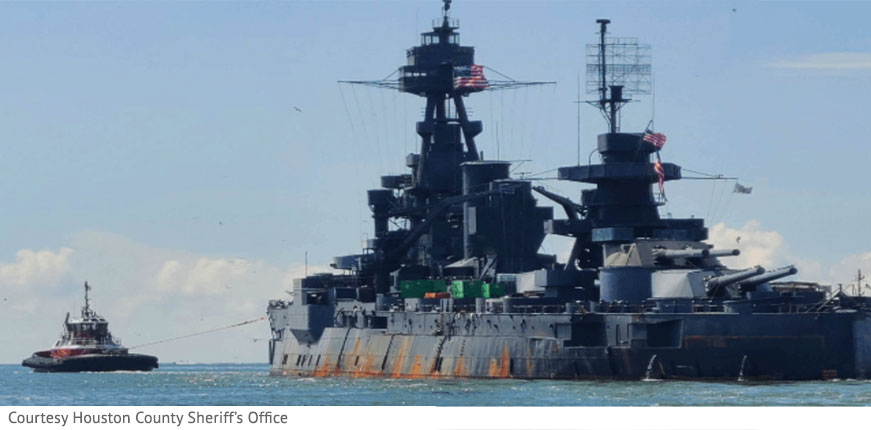
Battleship USS Texas Transits to Galveston for Dry Docking
The legendary battleship USS Texas has returned from its brief trip to the Gulf Copper shipyard in Galveston, where her hull needs urgent repairs. After 108 years on the water, the old ship’s hull has known leaks, thus the trip was carefully planned and supervised.
Four tug escorts, a diving support vessel, and a U.S. Coast Guard escort accompanied the battleship on its journey. She sailed away from San Jacinto before sunrise, being pulled south at a constant speed of roughly three knots. She landed at Gulf Copper’s facilities in the middle of the day after a smooth sail. When she arrived in Galveston, hundreds of well-wishers came up to welcome her, and other ships followed her on her unusual journey.
BREAKING: The Battleship Texas has arrived in Galveston! pic.twitter.com/5PxEuYQmze
— The Salty Dog Galveston (@SaltyDGalveston) August 31, 2022
The only battleship from both world wars that is still afloat is the USS Texas. She was commissioned in 1914 and performed escort duty throughout World War I. She participated in both the Pacific and the Atlantic theaters of the Second World War, delivering beach bombardment with her 14-inch guns during the landings in Morocco, Normandy, Iwo Jima, and Okinawa—or, more specifically, during the majority of the war’s significant amphibious operations.
After the war, USS Texas went into retirement, and the Battleship Texas Commission of the State of Texas has been looking after her ever since. Due to water intrusion and hull damage, a common issue for elderly museum ships, the USS Texas has frequently had to run her bilge pumps at a high rate in recent years. (Earlier this year, the decommissioned destroyer USS The Sullivans almost sank at the pier because of tiny holes in the ailing hull armor.) Before the transit, salvors added more pumps to the ship as a preventative measure, and they sealed all watertight hatches before launching.
The undertaking has taken a while to complete. Gulf Copper was awarded the contract to fix the USS Texas, and it required another drydock to finish the job. The yard bought a portion of a used floating drydock from Grand Bahama Shipyard rather than buying or building a new one (GBS). It was fixed and towed to Texas, where it finally arrived in June. Work can now start after the USS Texas was successfully floated aboard.
Here are a few pictures of the Battleship Texas. pic.twitter.com/vNheTEjqFo
— Galveston Ferry (@GalvestonFerry) August 31, 2022
The #BattleshipTexas, the 1910 vessel that took part in both WWI and II, was towed from the San Jacinto Battleground to its new home. Our HCSO maritime tactical operation section assisted with security escort. #HouNews pic.twitter.com/ogU5NyOl0m
— Ed Gonzalez (@SheriffEd_HCSO) August 31, 2022

